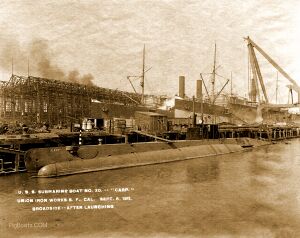F-class: Difference between revisions
Pbcjohnston (talk | contribs) mNo edit summary |
Pbcjohnston (talk | contribs) No edit summary |
||
| Line 4: | Line 4: | ||
<font size="5>F-1 (Submarine #20)</font> | <font size="5>F-1 (Submarine #20)</font> | ||
[[File:Red bar sub.jpg]] | [[File:Red bar sub.jpg]] | ||
[[File:F-1 Carp-Union Iron 1911.jpg|left|thumb|Photo contributed by Darryl Baker from the files of the Vallejo Naval & Historical Museum.]]<br>The yet to be commissioned submarine Carp seen dockside at the Union Iron Works Shipyard in San Francisco. The vertical "21" on her conning tower fairwater IS NOT her hull number. These vertical numbers were to denote the boat's place in an at-sea steaming formation. This was a common practice of the day, and unfortunately the ease at which these numbers could be mistaken for the hull number was apparently lost on the Navy. The two large ocean liners in the background are the SS Ventura and the SS Sonoma, both of which plied the U.S. to Australia passenger trade. | [[File:F-1 Carp-Union Iron 1911.jpg|left|thumb|Photo contributed by Darryl Baker from the files of the Vallejo Naval & Historical Museum.]]<br>The yet to be commissioned submarine Carp seen dockside at the Union Iron Works Shipyard in San Francisco. The vertical "21" on her conning tower fairwater IS NOT her hull number. These vertical numbers were to denote the boat's place in an at-sea steaming formation. This was a common practice of the day, and unfortunately the ease at which these numbers could be mistaken for the hull number was apparently lost on the Navy. The two large ocean liners in the background are the SS Ventura and the SS Sonoma, both of which plied the U.S. to Australia passenger trade. | ||
[[F-1|See More F-1 photos]]<br><br><br><br><br><br><br><br><br> | |||
<font size="5">F-2 (Submarine #21, later SS-21)</font> | <font size="5">F-2 (Submarine #21, later SS-21)</font> | ||
[[File:Red bar sub.jpg]]<br><br> | [[File:Red bar sub.jpg]]<br><br> | ||
Revision as of 12:08, 29 April 2023
Design, Construction, and Naming Notes
![]()
The F-class were harbor defense submarines designed by the Electric Boat Company (EB) of New York City (later Groton, CT.) They were built by two different yards: F-1 and F-2 were constructed at Union Iron Works of San Francisco. F-3 and F-4 were built at The Moran Company of Seattle, the first submarines built in the Pacific Northwest. These boats were originally named Carp, Barracuda, Pickerel, and Skate (in order). On November 17, 1911, while still under construction, the Navy changed its naming convention for submarines and these boats received their F-class names. They were commissioned with the F names in mid 1912 and early 1913. F-2 and F-3 survived long enough to have their original general submarine series designation changed to the SS series on July 17, 1920. F-1 and F-4 had been lost in accidents by that time and were not officially redesignated.
F-1 (Submarine #20)
![]()

The yet to be commissioned submarine Carp seen dockside at the Union Iron Works Shipyard in San Francisco. The vertical "21" on her conning tower fairwater IS NOT her hull number. These vertical numbers were to denote the boat's place in an at-sea steaming formation. This was a common practice of the day, and unfortunately the ease at which these numbers could be mistaken for the hull number was apparently lost on the Navy. The two large ocean liners in the background are the SS Ventura and the SS Sonoma, both of which plied the U.S. to Australia passenger trade.
See More F-1 photos
F-2 (Submarine #21, later SS-21)
![]()
F-3 (Submarine #22, later SS-22)
![]()
F-4 (Submarine #23)
![]()